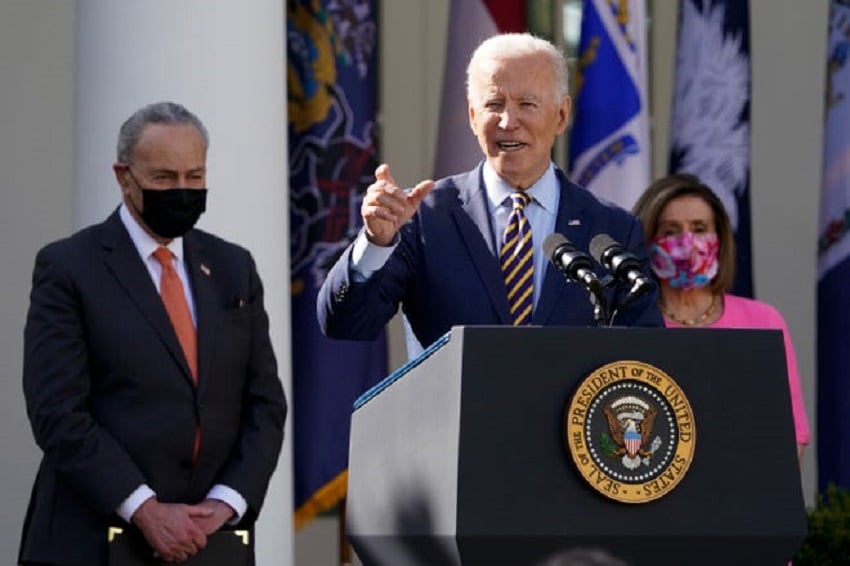WASHINGTON – Millions of people can begin signing up on April 1 for new health insurance premium subsidies made available through the COVID-19 relief package, the Biden administration announced Friday.

The $1.9 trillion stimulus bill President Joe Biden signed into law Thursday increases subsidies to those who were already eligible through state and federal marketplaces. It also makes help newly available to people earning more than four times the federal poverty level.
Premiums will decrease an average of $50 a month per person, according to the Department of Health and Human Services. But some people could save hundreds of dollars each month.
Biden signs stimulus: President Biden signs $1.9 trillion COVID-19 relief bill with $1,400 stimulus checks into law
Republicans, who unanimously opposed the legislation, have criticized the subsidies as too expensive and said they’re among the bill’s many provisions that aren’t directly related to fighting the coronavirus.
The subsidies will cost taxpayers about $34 billion and provide coverage to 1.3 million Americans who otherwise would be uninsured, according to the nonpartisan Congressional Budget Office. Millions more could reduce their insurance costs.
Designed to help people afford health care during the pandemic, the bump in assistance is for two years.
But it’s the largest expansion of health care help since the passage of the 2010 Affordable Care Act. The subsidies are also part of a bigger package of health care reforms Biden promised during the campaign to pursue as permanent changes.
Even as the relief package worked its way through Congress, the administration reopened enrollment on HealthCare.gov, the insurance marketplace created by the ACA for people not covered by an employer or through a government plan like Medicare and Medicaid. More than 200,000 people signed up for a plan in the first two weeks of the special enrollment period, which began Feb. 15.
Enrollment continues through May 15 on the federal site, as well as on most of the state-run sites.
The 14 states that operate their own insurance exchanges are aiming to also start processing the new subsidies on April 1, according to HHS. But those details will be announced by individual states.
Stimulus bill:Restaurants, bars decimated by pandemic getting billions from Biden’s COVID-19 stimulus bill
Those already enrolled who don’t reapply can still receive the extra savings when filing 2021 taxes next year.
People who already have insurance through an exchange can either apply the new subsidies to their existing plan to lower their monthly payments or can switch plans. Switching could allow someone to buy a plan with a much lower deductible, with the higher subsidy covering that plan’s higher premium.
For example, for someone earning between 100-150% of the poverty level, the subsidies would cover all of the premium for a mid-level plan with an average deductible of $177. By contrast, the lower-level plans the basic ACA subsidies cover have a typical deductible of about $6,900.
A single person earning about $51,520, or a family of four with a household income of $106,00 – which is four times the federal poverty level – will get premium assistance for the first time.
COVID vaccines:Dentists and midwives giving shots, 4,000 troops to help: How Biden is expanding COVID-19 vaccinations
The changes will provide the most savings to people at that income level and above who are older or live in areas with particularly high premiums.
A 60-year-old person making $55,000 per year living in Wyoming, West Virginia, South Dakota, Nebraska, Connecticut or Alabama could save more than 70% on a midrange plan, according to the Kaiser Family Foundation, a nonpartisan health research organization.
HHS did not estimate how many people are expected to take advantage of the new subsidies.
The administration is planning an extensive outreach campaign that includes a big push on March 23, the 11th anniversary of the ACA.
While President Barack Obama’s signature domestic bill expanded coverage to more than 20 million Americans, nearly one in ten are still uninsured.
Under the original ACA subsidies, 14% of people using the marketplaces can buy a mid-level plan for $10 or less per month, according to HHS. With the new help, more than half can. And, HHS estimates 3.6 million people without insurance are newly eligible for help.
Takeaways from Biden’s speech:Small gatherings by July 4, denouncing racist attacks and a contrast to Trump
